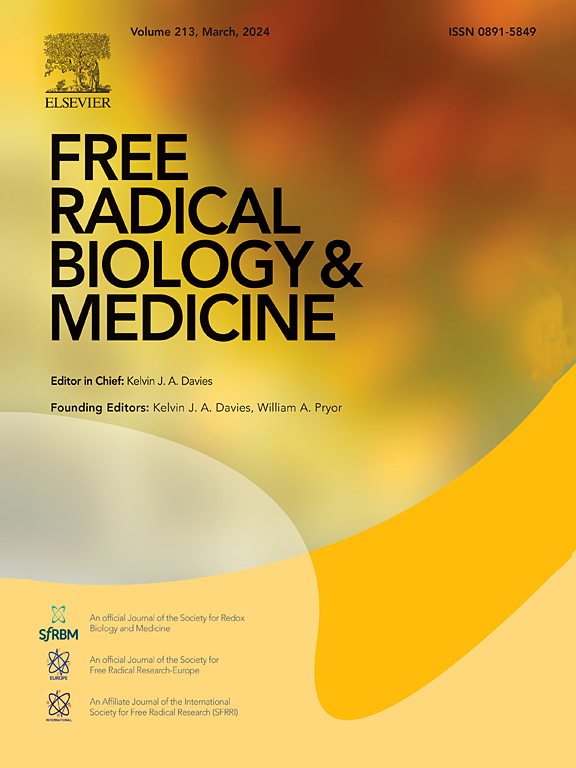发现基于没食子酸的线粒体抗氧化剂可减轻 LPS 诱导的神经炎症
IF 7.1
2区 生物学
Q1 BIOCHEMISTRY & MOLECULAR BIOLOGY
引用次数: 0
摘要
线粒体是一种复杂的细胞器,在能量代谢、应激反应调节方面发挥着关键作用,同时也是生物合成过程的主要枢纽。线粒体除了在细胞能量代谢方面具有公认的功能外,还是细胞内活性氧(ROS)的主要来源,ROS 具有信号分子的功能,过量产生时会导致氧化应激。此外,线粒体功能障碍是神经炎症的主要原因之一。为此,我们以没食子酸和三苯基膦(TPP)阳离子为基础,合理设计了一种三嗪类线粒体抗氧化剂(Mito-TBA),专门针对线粒体来缓解神经炎症。体外 Mito-TBA-3 可抑制线粒体自噬,通过抑制 LPS 诱导的 TLR-4 激活和激活 PC-12 神经元中的 Nrf-2/ ARE 通路来提供神经保护。在 LPS 诱导的神经炎症大鼠模型中,Mito-TBA-3 能挽救记忆缺陷、逆转抑郁样行为、抑制神经炎症并减少促炎细胞因子。总之,基于生物物理、体外和体内分析,Mito-TBA-3 作为一种有效的治疗先导分子,为抗击神经退行性变提供了宝贵的见解,其疗效甚至优于一种著名的非甾体抗炎药物(阿司匹林)。本文章由计算机程序翻译,如有差异,请以英文原文为准。
Discovery of gallic acid-based mitochondriotropic antioxidant attenuates LPS-induced neuroinflammation
Mitochondria are complex organelle that plays a pivotal role in energy metabolism, regulation of stress responses, and also serve as a major hub for biosynthetic processes. In addition to their well-established function in cellular energetics, it also serves as the primary site for the origin of intracellular reactive oxygen species (ROS), which function as signaling molecules and can lead to oxidative stress when generated in excess. Moreover, mitochondrial dysfunction is one of the leading cause of neuroinflammation. In this regard, we have rationally designed a triazine derived mitochondriotropic antioxidants (Mito-TBA), based on gallic acid and triphenylphosphonium (TPP) cation to specifically target mitochondria to mitigate neuroinflammation. In vitro Mito-TBA-3 inhibits mitoautophagy, offers neuroprotection by inhibiting the LPS induced TLR-4 activation and activating the Nrf-2/ARE pathway in PC-12 derived neurons. In vivo Mito-TBA-3 rescue memory deficit, reversed depression like behavior, inhibited neuroinflammation, and decreased proinflammatory cytokines in LPS induced neuroinflammation rat model. Overall, based on biophysical, in vitro and in vivo analysis, Mito-TBA-3 offers valuable insights as a potent therapeutic lead molecule to combat neurodegeneration even outperforming a well-known non-steroidal anti-inflammatory drug (Aspirin), it also has the potential to use as a promising therapeutic candidate for other mitochondrial oxidative stress related disorders.
求助全文
通过发布文献求助,成功后即可免费获取论文全文。
去求助
来源期刊

Free Radical Biology and Medicine
医学-内分泌学与代谢
CiteScore
14.00
自引率
4.10%
发文量
850
审稿时长
22 days
期刊介绍:
Free Radical Biology and Medicine is a leading journal in the field of redox biology, which is the study of the role of reactive oxygen species (ROS) and other oxidizing agents in biological systems. The journal serves as a premier forum for publishing innovative and groundbreaking research that explores the redox biology of health and disease, covering a wide range of topics and disciplines. Free Radical Biology and Medicine also commissions Special Issues that highlight recent advances in both basic and clinical research, with a particular emphasis on the mechanisms underlying altered metabolism and redox signaling. These Special Issues aim to provide a focused platform for the latest research in the field, fostering collaboration and knowledge exchange among researchers and clinicians.
 求助内容:
求助内容: 应助结果提醒方式:
应助结果提醒方式:


